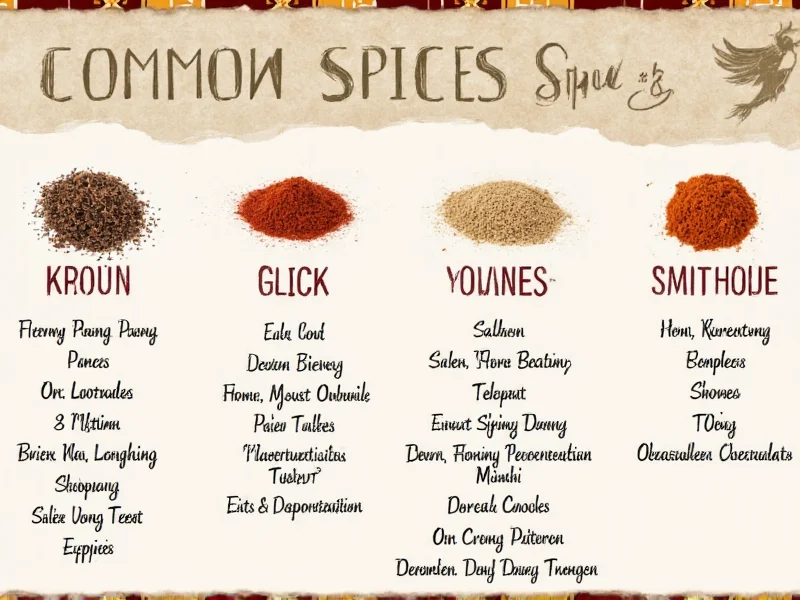Building a well-stocked spice collection transforms ordinary meals into extraordinary culinary experiences. Understanding which spices are truly essential can save both space and money while dramatically improving your cooking. This comprehensive guide details the most common spices you'll encounter in recipes worldwide, their flavor profiles, and practical applications in everyday cooking.
Top 10 Essential Spices for Every Kitchen
Every home cook should have these foundational spices. They provide versatility across multiple cuisines and form the backbone of flavor development in countless dishes. Unlike specialty spices used for specific recipes, these workhorses appear consistently in everyday cooking.
| Spice | Flavor Profile | Common Culinary Uses | Storage Life |
|---|---|---|---|
| Black Pepper | Sharp, pungent, slightly floral | Universal seasoning, meats, vegetables, sauces | 3-4 years (whole), 1-2 years (ground) |
| Cumin | Earthy, warm, slightly smoky | Tacos, chili, curries, roasted vegetables | 2-3 years |
| Paprika | Sweet, mild pepper flavor (varies by type) | Goulash, deviled eggs, rubs, soups | 2-3 years |
| Cinnamon | Warm, sweet, woody | Baking, oatmeal, Moroccan tagines, chai | 3-4 years |
| Garlic Powder | Concentrated garlic flavor | Rubs, marinades, sauces, roasted vegetables | 2-3 years |
Comprehensive Common Spices List
Expanding beyond the essentials, this detailed common spices list covers additional versatile options that enhance specific cuisines or cooking techniques. Understanding these spices and their applications helps you build a more sophisticated flavor palette.
Spice Profiles and Applications
Each spice brings unique characteristics to dishes. Proper usage depends on understanding flavor profiles and how they interact with other ingredients. Here's an expanded common spices list with practical guidance for home cooks.
| Spice | Origin | Flavor Notes | Best Pairings |
|---|---|---|---|
| Turmeric | India | Earthy, slightly bitter, peppery | Rice dishes, curries, golden milk, roasted vegetables |
| Ginger | Asia | Warm, pungent, slightly sweet | Asian cuisine, baked goods, teas, marinades |
| Oregano | Mediterranean | Robust, slightly bitter, aromatic | Tomato sauces, pizza, grilled meats, Greek salads |
| Chili Powder | Mexico | Varies from mild to hot, complex | Tacos, enchiladas, chili, spice rubs |
| Nutmeg | Indonesia | Warm, sweet, slightly nutty | Béchamel sauce, mashed potatoes, baked goods, eggnog |
Organizing Your Spice Collection
An effective spice organization system ensures you actually use what you've purchased. Many home cooks accumulate spices then struggle to find them when needed. Consider these practical approaches for maintaining an accessible spice collection:
- Alphabetical arrangement - Makes finding specific spices efficient
- Cuisine-based grouping - Keep Mediterranean, Asian, or Mexican spices together
- Frequency of use - Place most-used spices at eye level for quick access
- Label clearly - Include purchase date to track freshness
Proper Spice Storage Techniques
Spice longevity depends significantly on storage conditions. Exposure to light, heat, and moisture rapidly degrades flavor compounds. Follow these evidence-based storage recommendations:
- Store in airtight containers away from direct sunlight
- Keep away from heat sources like stoves or ovens
- Maintain consistent room temperature (60-70°F / 15-21°C)
- Avoid storing spices above the stove where heat and steam accumulate
- Consider dark glass or opaque containers for light-sensitive spices
Whole Spices vs. Ground Spices
Understanding when to use whole versus ground spices significantly impacts flavor quality. Whole spices maintain potency longer but require additional preparation. Here's what every cook should know about this fundamental distinction:
- Whole spices last 2-4 years and should be toasted then ground before use for maximum flavor release
- Ground spices have 1-2 year shelf life and offer immediate convenience but lose potency faster
- Best candidates for toasting: cumin seeds, coriander, fennel, mustard seeds
- Investment worth making: a dedicated spice grinder (coffee grinder works well)
Identifying Stale Spices
Spices don't technically expire but lose flavor potency over time. Recognizing when spices have passed their prime prevents disappointing results. Use these practical tests:
- Color test - Faded color indicates diminished potency
- Aroma test - Rub between fingers; weak scent means diminished flavor
- Taste test - Dull flavor without characteristic pungency
- Clumping - Indicates moisture exposure and potential flavor degradation
Building Your Personal Spice Collection
Start with the essential common spices list, then expand based on your cooking preferences. Rather than accumulating every spice available, focus on those relevant to cuisines you regularly prepare. This targeted approach creates a more functional spice collection that actually gets used. Remember that proper storage and rotation practices matter as much as the spices themselves for achieving consistently flavorful results.











 浙公网安备
33010002000092号
浙公网安备
33010002000092号 浙B2-20120091-4
浙B2-20120091-4